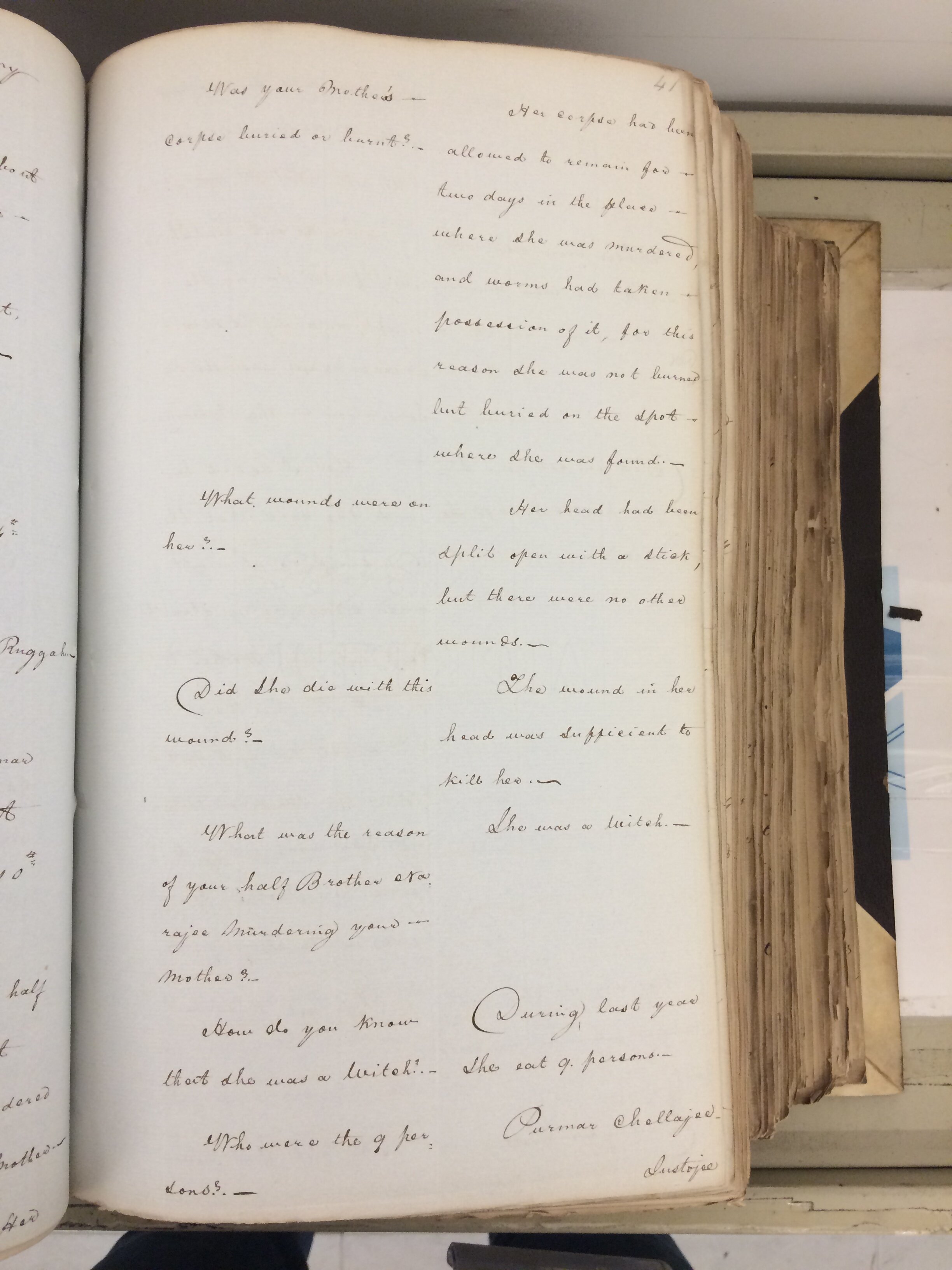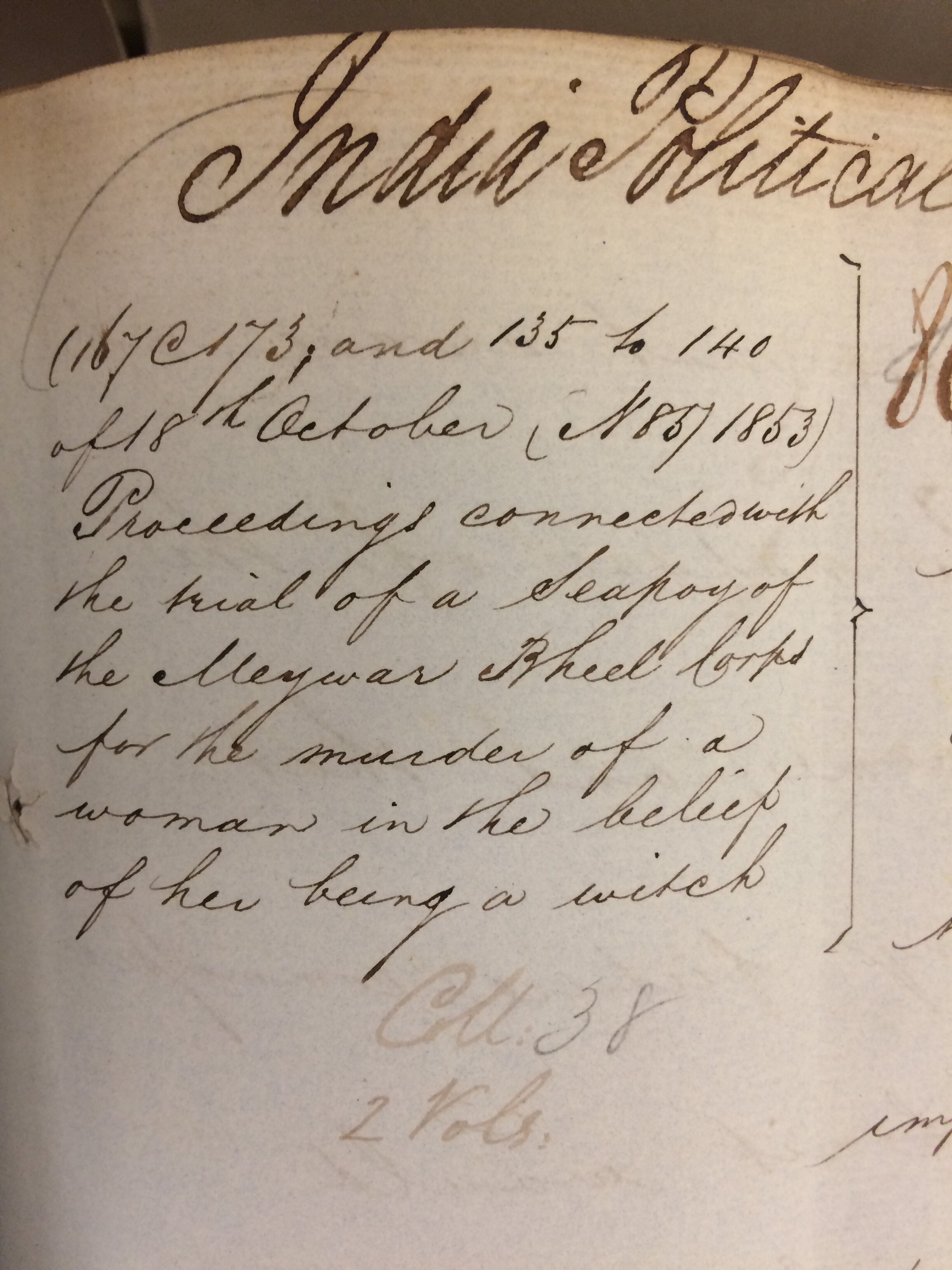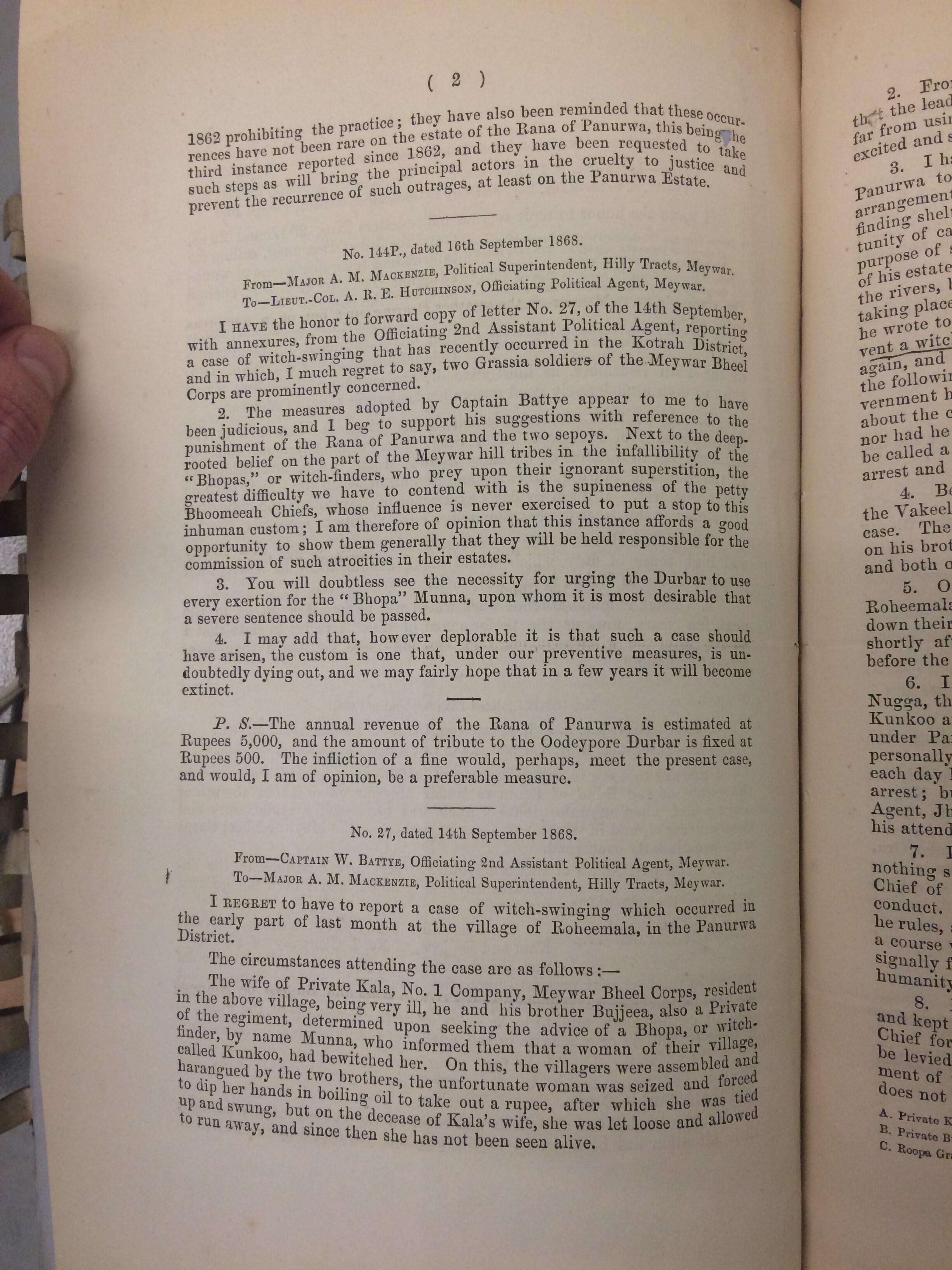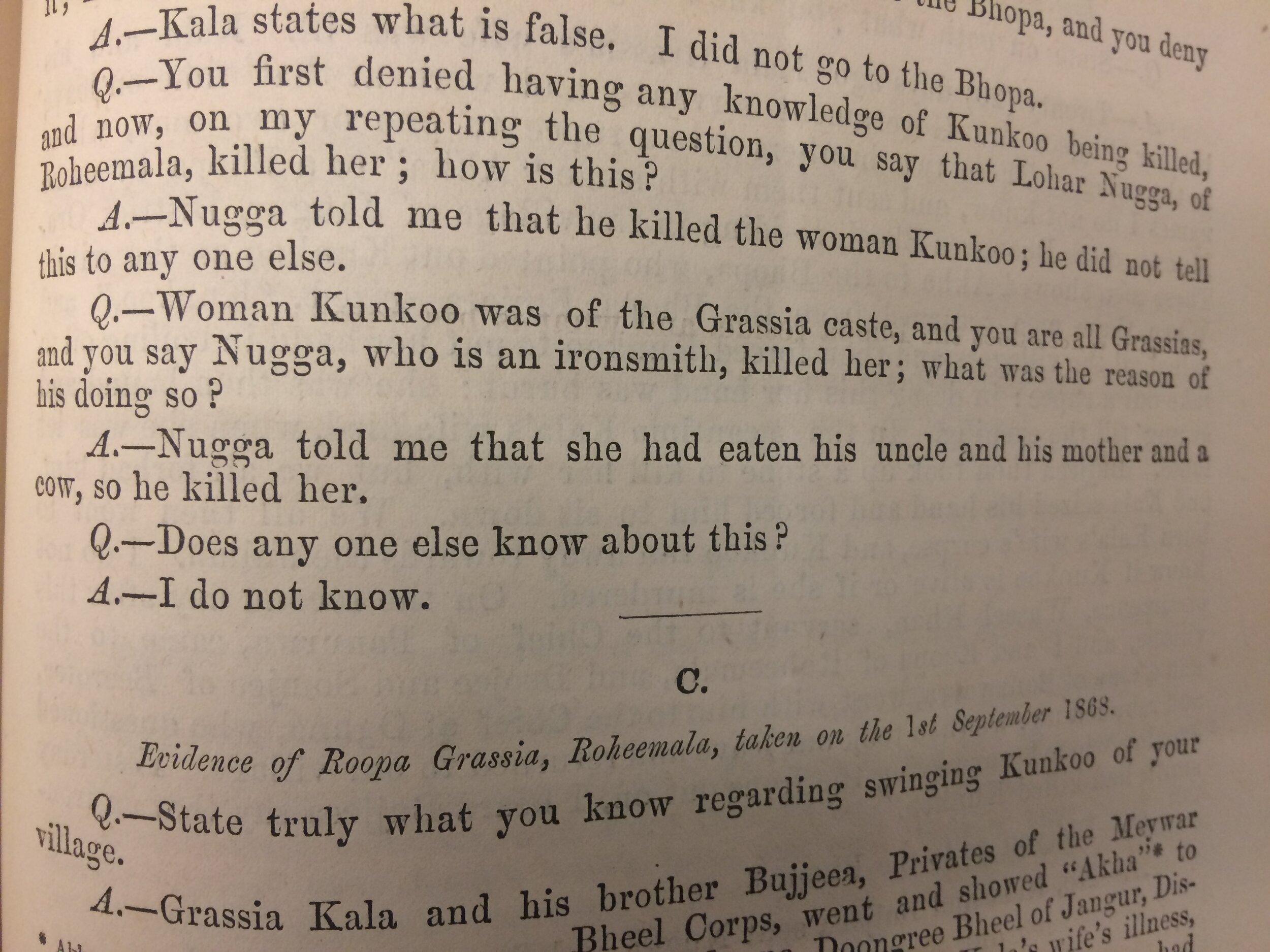My dearest Emily,
As we continue in this uncertain situation, I have been focusing my energy on the research of our collections at the Library. I stumbled upon some revealing documents regarding the attempts to quell the trend of witch hunting in India during the 19th century.
Belief in witches is an ancient tradition, as are the processes for discovering witchcraft and the often brutal techniques engaged to determine guilt or innocence.
Many of us are familiar with the infamous 17th-century witch hunts in Britain and America, events which spawned imaginative and gruesome literature and stirred a supernatural phenomenon intriguing worldwide audiences to this day.
Far from the glamour of fiction, the true war against witches was a horrifying affair. We look back with shame at the vile and unnecessary persecution of women during these periods. Cruel tortures all too easily excused through demonic accusation.
Whilst attitudes towards witchcraft in Britain had mostly altered by the 19th century, some of the countries engulfed by its Empire still experienced events with frightening parallels. The theatre of witch-hunting, sham trials, torture and murder, were prevalent throughout India.
A wealth of correspondence and reports in the India Office collections offer a unique insight into attempts by the British Government to stamp out these archaic practices. There are detailed proceedings of trials, first-hand accounts and correspondence between officers and officials attempting to control the issue.
Usually, villagers would seek advice from a local witch hunter, or Bhopa, who would identify the witch. The most common punishment for witchcraft in India was witch swinging. From the records available, it appears survival was rare. One report offered the following description:
“Without trial or being heard in defence, the supposed witch is seized, her eyes stuffed with red chillies and bandaged and ropes are tied firmly round her legs and waist. She is then taken to a tree and swung violently, with her head downwards, from about 9 O’clock to sunset each day, till she confesses to a falsehood or dies under the barbarous infliction. She is never loosed or unbound day or night.”
Many other indecencies and tortures were conducted, and even if the accused somehow survived these horrendous ordeals, they were exiled from their homes and branded a witch forevermore.
During a case in the Singhbhum district in 1822, an entire family of seven were violently murdered by an individual who claimed the head of that family was “in the habit of destroying people by witchcraft”. The suspect was soon detained, but in an event which surely did nothing to quell the fears of superstitious witnesses, the murderer suffered “sudden death as a consequence of epilepsy” just before his trial.
In 1842, a woman in Palachpoor was found to have been brutally murdered in the jungle close to her village, her head split open by a blow from a large stick. The chief suspect was her step son. When cross examined, he claimed she had been practicing witchcraft and had “eaten two buffaloes of mine and 10 persons of the village, including his brother’s wife and sister’s daughter”. The woman’s own daughter admitted in court that her mother had always been a witch, announcing “she used to bite people and they died in consequence”. Her younger son went further exclaiming “she had an evil eye.” It emerged that the unfortunate woman had recently reported her step son’s involvement in a robbery. In his fury, he forced her into the jungle and beat her to death. Despite this knowledge, the jury felt, because of the witchcraft accusation, a verdict of murder was unfair. A short prison sentence and hard labour was agreed upon.
During 1849, a lady called Eullal, in the village of Chapra, was accused of witchcraft by village leaders. They claimed her eye had fallen upon a villager named Koobla, who had contracted an illness and died 11 days later. A gathering of village officials concluded that Eullal was guilty and, once it had been agreed to distribute her possessions and properties amongst themselves, Eullal was seized and charged. She had chili paste rubbed into her eyes before bandages were applied to stop her evil glare afflicting further victims. Eullal survived this ordeal and was left tied to a tree. The villagers departed at around 6pm. By 9pm, Eullal was dead. It was argued a slave had killed Eullal, under the orders of the Thakere. A punishment of 25 Rupees was suggested by the Raja.
In 1856 in the Mewar region, Captain John Brooke wrote of “the atrocity of the practice of swinging women” as he reported an eight month pregnant woman who was accused by a Bhopa of being a witch and swung to her death. He sadly lamented “I would remark that there is little hope of the custom ceasing till it becomes dangerous to follow the profession of Bhopa”.
In 1864, the mother of a man was accused of witchcraft when his wound, despite being sewn up, issued blood. It had been a family member who made the accusation. The mother was seized, stabbed with the sword and thrown into the river under the accusations of witchcraft. Somewhat conveniently, the family members involved in the unfortunate woman’s demise received her money and property shortly after her execution.
In 1868, on the advice of a Bhopa named Munna, a woman called Kunkoo was accused of making an Indian Army private’s wife sick by witchcraft. The soldier and his brother encouraged action from villagers, who seized Kunkoo and forced her hands into boiling oil, then swung her for days. The soldier’s wife died from her ailment and the old lady was released, only to be found murdered in the forest shortly after. During questioning the brothers denied killing Kunkoo, instead blaming another villager, Nugga. When asked why he would have reason to kill the old lady, Private Bujjeea claimed “Nugga told me that she had eaten his uncle and his mother and a cow, so he killed her”.
These and countless other cases were reported by the British authorities in India, many more undoubtedly went unreported.
Whilst the reports clearly indicate the government were keen to stamp out the practice, there was only so much they could achieve. They were wary of interfering with indigenous beliefs and traditions. Local leaders admitted in some areas 40-50 women a year could be punished as witches.
The response was to target the Bhopa’s. By convicting those “professed sorcerers” accusing individuals of witchcraft, and fining community leaders who allowed the events to occur, they hoped to quell the illegal occurrences of torture and murder.
Whether or not this was successful is debatable. Whilst reports of convictions must have had some effect, it more than likely only pushed them underground.
Craig Campbell
Curatorial Support Officer, India Office Records
British Library
Further reading:
IOR/L/PS/6/567, Coll 240 Papers regarding a case of 'witch-swinging' and murder which took place at the village of Rohimala, in Panurwa District, Udaipur State, on or about 9 August 1868
IOR/R/2/700/39 File Q/6 6 Witch craft cases from 1850
IOR/F/4/2016/90185 Mahee Caunta [Mahi Kantha]: Political Agent's Court of Criminal Justice, case No 1 of 1842, trial of Narajee Ruggajee charged with putting his stepmother to death on account of her being accused of witchcraft, Sep 1841-Jun 1843
IOR/F/4/830/21967 A Kol Sirdar in Sambalpur murders an entire family because of their alleged witchcraft, Feb 1822-Sep 1823
Images
IOR/F/4/830/21967 A Kol Sirdar in Sambalpur murders an entire family because of their alleged witchcraft, Feb 1822-Sep 1823
IOR/L/PS/6/567, Coll 240 Papers regarding a case of 'witch-swinging' and murder which took place at the village of Rohimala, Udaipur State
IOR/L/PS/6/567, Coll 240 Papers regarding a case of 'witch-swinging' and murder which took place at the village of Rohimala, in Panurwa District, Udaipur State, on or about 9 August 1868
IOR/R/2/700/39 File Q/6 6 Witch craft cases from 1850
IOR/F/4/2016/90185 Mahee Caunta [Mahi Kantha]: Political Agent's Court of Criminal Justice, case No 1 of 1842, trial of Narajee Ruggajee charged with putting his stepmother to death on account of her being accused of witchcraft, Sep 1841-Jun 1843
IOR/F/4/830/21967 A Kol Sirdar in Sambalpur murders an entire family because of their alleged witchcraft, Feb 1822-Sep 1823
- all public domain creative commons license
Also Posted by India Office Records at 09:00:00 in Crime , South Asia , Women's histories







